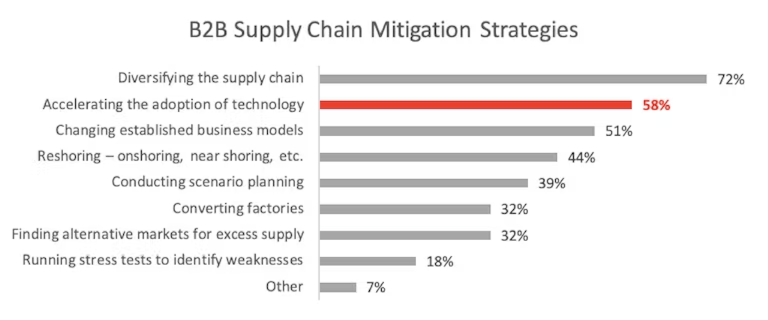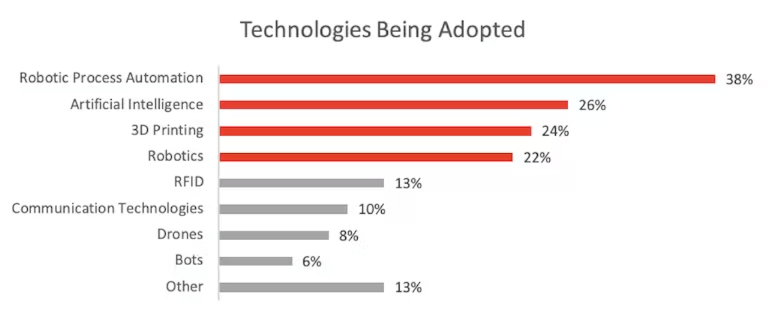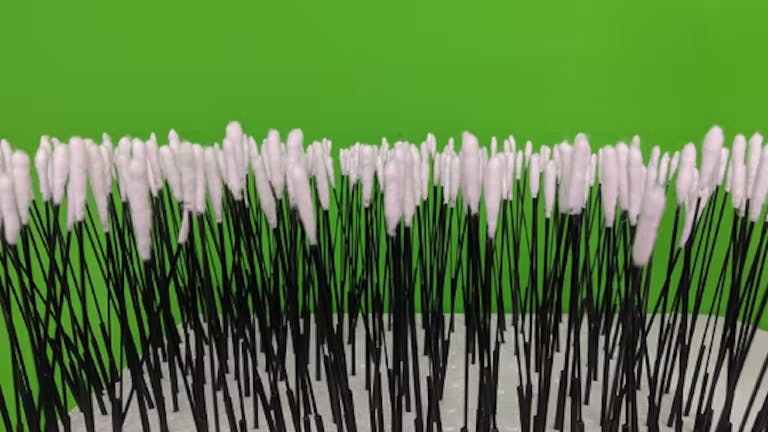To Mitigate Resource Impacts
Traditionally, manufacturing has led other sectors in the adoption of some types of technologies – like automation and 3D printing – and has lagged in the adoption of others – like artificial intelligence and e-commerce. Covid-19 is accelerating adoption of technologies that are effective in mitigating pandemic impacts.
The pandemic has disrupted supply chains, staffing and other resources. Technology is part of the solution.
In a recent Big Village survey of global supply chain experts, 72 respondents with manufacturing expertise named “accelerating the adoption of technology” a top strategy to mitigate the supply chain impacts of the pandemic, second only to “diversifying the supply chain.”

Which mitigation strategies are business-to-business supply chains considering, developing or implementing? (n=72)
Robotic Process Automation is the top mitigation strategy.
The top technologies for mitigating Covid-19’s impact on B2B supply chains are robotic process automation (RPA), artificial intelligence (AI), 3D printing, and robotics, according to Big Village’s B2B supply chain survey.

Which of the following technologies are being considered, developed, or implemented as a part of mitigation strategies for business-to-business supply chains? (n=72)
The pandemic is a multiplier to existing drivers of technology adoption, so adoption is accelerating.
For each of the top technologies, existing drivers of adoption are compounded by drivers related to Covid-19. This means adoption is accelerated. Using these technologies in combination can multiply their impacts. AI, in particular, boosts the power of RPA and other technologies.
Robotic process automation and robotics are important for the efficiency, consistency, and cost reduction they bring, which are all the more important in this time of economic pressure. Now, an added reason for adoption is that automation and robotics enable social distancing to keep workers safe. Additionally, automation means fewer workers are needed, so labor costs are less important in determining where to locate manufacturing. Moving manufacturing closer to end markets alleviates supply chain challenges. The combination of these drivers make automation a priority.[i]
Companies should “automate processes [because] manual processes lead to mistakes and inefficiency.” – Big Village Expert
With the pandemic, there have been “greater investments in robotics in novel applications areas such as meat packing plants.” – Big Village Expert 735800
Artificial intelligence has numerous applications in manufacturing and supply chains, including robotic process automation, computer vision, preventive maintenance, machinery inspection, autonomous materials movement, inventory monitoring, revenue and sales forecasting, and spend analytics. Part of the value of AI is that across applications it can handle routine tasks, freeing up staff to focus on higher-value work. The efficiencies delivered by AI mean less stress on supply chains and on workers, both of which are crucial during the pandemic and will provide cost savings even after the pandemic has passed.[ii], [iii], [iv], [v]
AI enables RPA to such a degree that “many vendors are now brandying about terms like Intelligent Automation (IA) or Intelligence Process Automation (IPA).” [vi]
“Intelligent logistics is [expected] to get more attention post-pandemic. The ability to intelligently route manufactured goods will be crucial to help build more resilient supply chains, which in some cases will focus more on just-in-case than just-in-time.” [vii]
3D printing has been quickly deployed to address product shortages arising with the pandemic, thanks to its flexibility. Of particular note, 3D printing has accelerated production of personal protection equipment. The flexibility to quickly make a wide variety of products has always been 3D printing’s key strength. This has been further proven in the current environment. Moving forward, the need to respond to change and manage risk in supply chains will continue to drive the growth of 3D printing.
“The most interesting changes were the increased use of 3-D-Printing to create parts for respirators, face shields and other helpful components… The awareness of this technology will get a boost.” – Big Village Expert 735263
One application is a “3D printed nasopharyngeal test swab, designed for use in COVID-19 testing.” – Big Village Expert 733882
Initial tests suggest a 3D printed COVID-19 test swab “may be more efficient at collecting viral particles and may reduce the rate of false negatives” than a commercial swab.[viii]

Source: Markforged
Even manufacturers that have already adopted these technologies have work to do.
Manufacturers who had begun to adopt technology prior to the pandemic are in a better position now than those that had not. Using RPA, AI, 3D printing, and robotics in any application makes it significantly easier to expand use to other applications. Getting started is the hardest part. But even companies already using these top technologies must further expand use to effectively mitigate the impacts of the pandemic.
When times are tight, making investments is hard, but remains necessary for long-term success. Leasing or X-as-a-Service can help, by spreading expenses out over time.
‘“Robots as a service keeps you away from having to have that capital expenditure, and you reduce that implementation time from months to in some cases weeks,” said Randy Bradley, associate professor of information systems and supply chain management at the University of Tennessee. For smaller players, robotics as a service may allow them to compete with larger players, particularly given the currently erratic supply chain. Furthermore, he said, the robotics-as-a-service model requires less ramp-up time to train robots. “Many robots as a service rely on lasers or sonar, so you don’t have to retrofit a facility or spend time training them to use them,” Bradley said.’ [i]
The key to planning for the future while managing risk is determining where to focus. Covid-19 has put a spotlight on key issues that existed before the pandemic but have been exacerbated by it. By assessing the value of technology solutions to address both Covid-19-related challenges and long-standing inefficiencies, manufacturers can be sure they’re making the best investments for the short-term and the long-term.
Making Sense of the New Normal: How Big Village Can Help
The Covid-19 pandemic has caused several businesses, and even broad industries, to completely rethink the way that they operate. Further exploration will be required for companies to define their strategies in the post-pandemic world.
Big Village has broad experience in supporting the B2B environment, from manufacturing to CPG, to technology, healthcare, financial services and transportation. Big Village is equipped with the right experiences and approaches.
In helping to build new operations and processes amid Covid-19, Big Village has key insights solutions that support our clients’ technological evolutions:
Assessing External Forces:
- Adopting New Technology: For many firms adopting new technology means finding the right partners that truly understand their business and how to develop the precise technology that is needed. And as technological solutions become increasingly important it is imperative for businesses to accelerate new technology adoption. Analyzing partner options can be arduous and we can help to simplify the process.
- Evaluating the State of the Market: As the market evolves and new technology advances it is vital to maintain a pulse of market changes and key competitors to help identify white space opportunities or create differentiated options.
Building the Right Internal Approaches:
- Evolving Business Processes: With the monumental changes that are occurring in the world, businesses are also tasked with looking at internal process to assess the best next steps to grow in a post-pandemic world. At Big Village we understand that a system to address the ecosystem is important.
- Know the Customer
- Connect Customer Demands to Employee Needs
- Evaluate Process Changes with a Focus on Innovation
By taking a holistic view at evolving business needs, we can help you innovate the process by learning what your key customer segments want and need.
Future Proofing your Business:
- Supporting Future Practices: We partner with clients to identify shifts across markets and industries that can be modelled to build future best practices. An eye on the future can be all the difference between staying ahead and falling behind.
Written by Ashley James, Vice President at Big Village Insights.
[i] Lauren Horwitz, “Will COVID-19 Accelerate Robotics in the Supply Chain? COVID-19, and resulting worker health-and-safety requirements, have spurred interest in robotics in the supply chain.” IoT World Today, May 31, 2020
[i] Lauren Horwitz, “Will COVID-19 Accelerate Robotics in the Supply Chain? COVID-19, and resulting worker health-and-safety requirements, have spurred interest in robotics in the supply chain.” IoT World Today, May 31, 2020
[ii] Michael Chui and Sankalp Malhotra, “AI adoption advances, but foundational barriers remain,” McKinsey, November 13, 2018
[iii] Arif Cam, Michael Chui, and Bryce Hall, “Global AI Survey: AI proves its worth, but few scale impact,’ McKinsey, November 22, 2019
[iv] “Artificial Intelligence (AI) in Manufacturing Market to Grow at a CAGR of 41.2% from 2020 to 2027 to reach $18.8 Billion by 2027- Pre and Post COVID-19 Estimates by Meticulous Research®,” Introdo GlobalNewsWire, June 4, 2020
[v] Nick Patience and Jeremy Korn, “How COVID-19 will impact use of AI/Machine Learning in Manufacturing, Energy and Media/Entertainment,” S&P Global Market Intelligence, May 7, 2020
[vi] CFB Bots, “The Difference between Robotic Process Automation and Artificial Intelligence,” medium.com, April 20, 2018
[vii] Nick Patience & Jeremy Korn, “How COVID-19 will impact use of AI/Machine Learning in Manufacturing, Energy and Media/Entertainment,” 451 Research, May 7, 2020
[viii] IW Staff, “Improving Swab Effectiveness Using 3D Printing,” Industry Week, April 9, 2020

